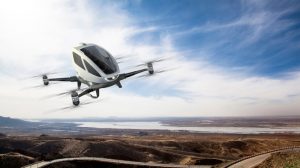EHang recently unveiled what it calls the world’s first personal Autonomous Aerial Vehicle (AAV) in a multirotor guise. Dubbed the 184, EHang’s latest and probably boldest creation to date is currently being showcased at CES 2016.
At the heart of the EHang 184 is a fully autonomous system designed for transporting one passenger and luggage at speeds up to 100km/h with flight times of up to 23 minutes.
The folks at EHang realize the risks and hassle of having human pilots operate flying vehicles so the 184 was designed to be fully autonomous to eliminate the possibility of human error and the need for a pilot’s license.

The world’s first electric, personal Autonomous Aerial Vehicle (AAV) – EHang 184 (PRNewsFoto/EHANG)
Here are the EHang 184 specifications at a glance:
- Standing 1.5 meters tall and weighing 200 kilograms (440 pounds), the EHang 184 AAV has a load capacity of 100 kilograms (220 pounds), with the maximum output of 106W powered by eight motors. It’s designed to have the capability to carry a single passenger for 23 minutes’ duration flight at sea level at average cruising speed of 100 km/h.
- The EHang 184 AAV body consists of a cabin for single passenger with a gull-wing door, a trunk and the power system composed of four arms and eight propellers on the bottom. The four arms, when folded, allow the AAV to occupy the same size parking space as consumer cars.
- Inside the cabin is placed a single seat, with a design similar to an F1 racing car seat. In front of the seat is a tablet console, through which passengers can easily input commands. Additionally, the cabin’s built-in air conditioner automatically adjusts the in-cabin temperature. Complete with 4G Wi-Fi Internet, EHang 184 provides passengers with comfortable and enjoyable riding experiences.
Having computers take full control of a flying vehicle ferrying a human passenger, who has no control at all on the vehicle’s flight, may seem dicey but in reality, human error has been the main cause of most air disasters. Computers not only make significantly less mistakes than humans, they have also been routinely used in airplane autopilots for many years.
The EHang 184’s safety features include:
- Built in reinforcements for all flight systems, so that in the unlikely event that a component does fail, multiple backups are already in place to seamlessly take over.
- EHang’s independently developed Fail-Safe System ensures that if any components malfunction, or if there’s damage while the AAV is in-flight (i.e. from a bird), the aircraft will immediately begin taking the necessary precautions to ensure safety. The 184’s Fail-Safe System automatically evaluates the damage and determines whether the AAV will need to land to ensure its passenger’s safety.
- The EHang 184 AAV flight control systems have multiple sets of sensors that provide the drone a constant stream of real-time data.
- The 184’s communication system was also designed with a safety guarantee: every system is encrypted, and each AAV comes with an independent key.
- In the event of an emergency, passengers can elect to halt flight and simply hover in the air with just one click.
To fly in the EHang 184, a passenger simply gets into it and keys in the destination into a smartphone or tablet and the 184 will set the course on its own. The passenger can then just sit back and let the drone take over.
To make things safer, all EHang 184’s will operate in conjunction with a 24/7, real-time flight command center, that will monitor and control every single drone under its command. Among other things, the command center will be able to prevent any 184 from taking off in the event of heavy thunderstorms or unfavorable weather conditions.
EHang hopes to market the 184 not only to the personal transportation industry but also to other fields such as shipping, emergency services and retail.
“It’s been a lifetime goal of mine to make flight faster, easier and more convenient than ever. The 184 provides a viable solution to the many challenges the transportation industry faces in a safe and energy efficient way,” said EHang CEO Huazhi Hu.
“I truly believe that EHang will make a global impact across dozens of industries beyond personal travel. The 184 is evocative of a future we’ve always dreamed of and is primed to alter the very fundamentals of the way we get around.”
The concept of personal AAV’s is certainly a novel one but we reckon there will be plenty of obstacles to overcome to get the EHang 184 commercially available. Government regulations and other unaddressed safety concerns will certainly need to be addressed if the EHang 184 project is to successfully take off.
For instance, the 184’s massive and exposed propellers, all 8 of them, can prove to be a serious threat should the drone land in an urban area with plenty of people around. We’d love to see EHang update the design of the 184 to feature some lightweight prop guards.
Despite these hurdles, we believe the dawn of personal AAV’s is here and it is just a matter of time before the technology is perfected and safety issues addressed, making affordable personal air travel a reality in the near future.